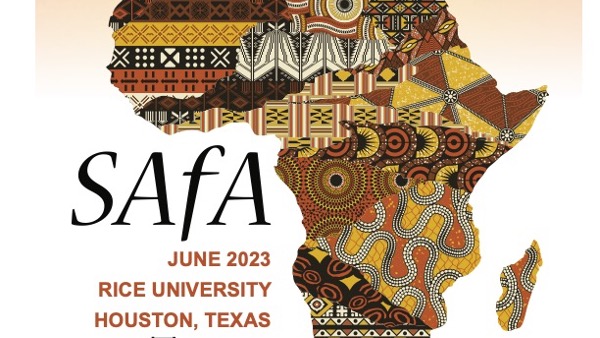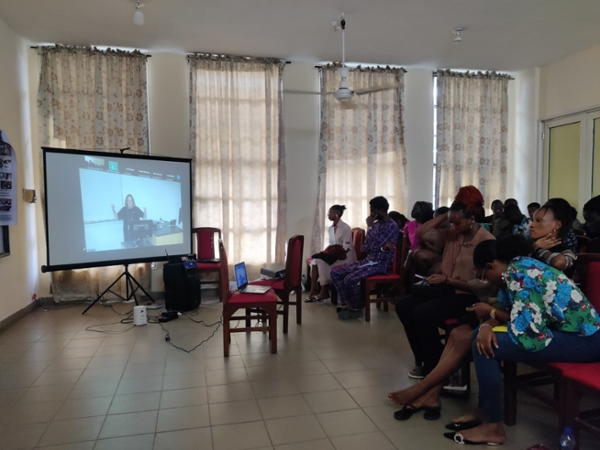William & Mary Anthropology Department Demonstrates its Leading Role in African Archaeology at the Society of Africanist Archaeologists (SAfA) 2023

From June 1st to June 6th 2023, the Society of Africanist Archaeologists (SAfA) held its 26th Biennial Meeting at Rice University, Houston, Texas, with additional conference hubs in Ibadan, Nigeria, and Nairobi, Kenya that connected virtually with the main event at Houston. Several faculty members, alumni, and graduate students from William & Mary distinguished themselves at various sessions, underscoring the university’s leading role in the study of African archaeology worldwide.
For the Student Day on June 1st, Tomos Llywelyn Evans, sixth-year Ph.D. candidate in Anthropology at William & Mary, was invited by the organizers to give a panel talk on excelling at grant applications. These Student Day sessions were aimed at providing student attendees of SAfA with useful information on various professional activities of importance such as publishing, finding funding, and applying for grants. Tomos spoke from his personal experiences in applying for and receiving external grants as a form of peer mentorship. He gave a presentation and answered questions at the Ibadan hub, from where he tuned in to virtually engage with the attendees in Houston.
On Sunday June 4th, a session co-chaired and co-organized by three William & Mary graduate students from Anthropology – Tomos Llywelyn Evans, Madeleine Gunter-Bassett, and Diogo Oliveira – was held. This was entitled Global Processes through Local Lenses: Perspectives from the Atlantic and Indian Ocean Coasts, and involved talks from across Africa. These contributions reflected on the deep-time global connectivity of the continent and the ways in which archaeology can help us better understand the role and perspectives of past African societies engaged in processes of long-distance trade and contact. Diogo – who did an excellent job handling things on the ground in Houston – opened the session with a talk entitled Mozambique Island and Cabaceira Pequena in the 16th century: perspectives on transforming maritime cultural landscapes in the Western Indian Ocean. Madeleine gave a talk based on her Ph.D. research further up the Indian Ocean coast entitled Local Ecologies and Regional Networks: An Analysis of Shell from two Late Holocene Sites in Djibouti. Professor Neil Norman, advisor to all three of the session co-chairs, discussed connections between West Africa and America in his talk on A Dahomean Prince in the Gulf Coast World: Archaeological Connections between Ouidah, Benin and Africatown, Alabama. Tomos, again speaking from the Ibadan hub, reflected on the archaeology of trade, movement, and conflict in southern Nigeria and the role of liminal monumental earthwork landscapes in mediating these, during his talk on Global Trade through the Lens of the Ìjèbú: Liminality and Regulation at Sungbo’s Eredo, Nigeria. Professor Adria Laviolette from the University of Virginia concluded the session as discussant, and other contributors from Nigeria and the United States – Julia Haines, Abiola Ibirogba, and Stanley Nwosu, gave fascinating talks on the historical archaeology of Mauritius and southern Nigeria respectively.

On Monday June 5th, there was yet another session in which William & Mary faculty and students played a leading role. The title of the session was Of Stones, Sherds, and Clay: The Archaeology of Built Urban Environments west of the Niger, chaired by Professor Gérard Chouin of William & Mary’s History Department, who has also been involved as a co-chair for graduate students in Anthropology. Dr. Olanrewaju Lasisi, who recently graduated from William & Mary Anthropology’s Ph.D. program, opened the session with his talk on Archaeology and Indigenous Hermeneutics: Interpreting the Multiplex Functions of Pavements which considered the astronomical role of potsherd pavement features in southern Nigeria that have been uncovered in archaeological work. Tomos Llywelyn Evans co-presented another talk, alongside his fieldwork collaborators Emmanuel Adeara and Stanley Nwosu, relating to his Ph.D. research at the Sungbo’s Eredo earthwork in southern Nigeria. This was entitled Mounds, Monuments, and Magic: Investigations of the Sungbo’s Eredo Earthwork Landscape, Nigeria, and was also given from the Ibadan hub.
African archaeology is a relatively small but rapidly expanding field within the larger discipline. In spite of being the second-largest continent on earth, it has taken a while for Africa’s myriad archaeological heritage to receive attention from mainstream archaeology, in spite of its often spectacular nature and the greater time-depth of the African archaeological record compared with other parts of the world. SAfA is a case-in-point: it is one of only two conferences dealing with the archaeology of the whole African continent (along with the PanAfrican Archaeological Association), and has more often been held outside Africa than it has within the continent. At large global archaeological conferences such as the Society for American Archaeology (SAA), typically only a very small handful of sessions deal with Africa (in its temporal and geographic entirety) while sessions on Central American or Near Eastern archaeology are abundant. As such, the fact that researchers from William & Mary played such a prominent role at SAfA is a significant achievement, as it shows that the university is increasingly taking a leading role in the study of African archaeology, at various parts of the continent. With faculty and graduate students holding expertise in the archaeology of Ghana, Benin, Nigeria, Djibouti, Tanzania, Mozambique, and the African diaspora, and with researchers regularly conducting pioneering research in these places, the university has developed into a veritable hub for the study of the African past.














